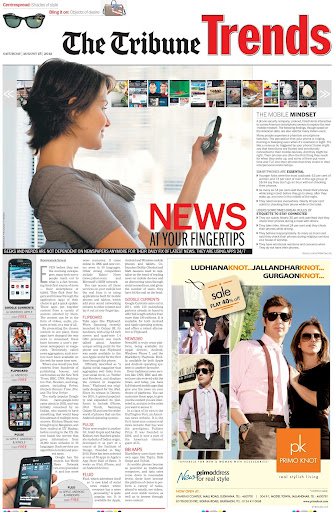Geeks and nerds are not dependent on newspapers anymore for their daily fix of latest news. They are using apps 24/7

Roopinder Singh
EVEN before they see the morning newspapers, many tech-savvy people reach out to what is a fast becoming their first source of news — their smartphone or tablet. They flick their fingers and browse through the application (app) of their choice to get a quick update. These apps put together content from a variety of sources selected by them. The content can be in the form of videos, audio, pictures or text, or a mix of all.
By presenting the chosen content in one place, these apps have changed the way news is consumed; these have become a user’s personal newspapers or magazines. Technically called news aggregators, such services have been available on the web for some time now.
Where else would you find content from hundreds of publishing houses, and such names as the New York Times, BBC, CNN, Washington Post,Reuters, and magazines, includingForbes, Harpers Bazaar, Time, Elle, andThe New Yorker.
The vastly popular Google News (news.google.com) came about in 2002, and was initially conceived by an Indian, who wanted to have something that would keep him abreast of multiple news sources. Krishna Bharat was brought up in Bangalore, and then studied at IIT Madras, before moving to the US. He now heads the service that gives information from 25,000 news websites in 25 languages. Such services use algorithms to index and present news.
Google has the muscle, but World News Network (wn.com) preceded it and has more news resources. It came online in 1998, and now covers news in 50 languages. Other strong competitors include Yahoo! News (news.yahoo.com) and Microsoft’s MSN network.
You can access all these services on your mobile but the real buzz is in using applications built for mobile phones and tablets, which add your social networking streams to other content and lay it out at your fingertips.
Take apps like Flipboard. When Samsung recently launched its Galaxy S3, its hardware, with a big 4.8 inch screen and quad-core 1.4 GHz processor, was much talked about. Another unique selling point for the phone was that Flipboard was made available to the non-Apple world for the first time through this phone.
Officially described as “a digital social magazine that aggregates web links from your social circle, i.e. Twitter and Facebook, and displays the content in magazine form,” Flipboard was originally designed for the iPad. Since its release in December 2010, it gained popularity and expanded its platforms to include iPhone, iPod Touch, Samsung Galaxy S3 and now the wider world of phones that use the Android operating system.
PULSE
Pulse news reader is another hit. Ankit Gupta and Akshay Kothari, two Stanford graduate students of Indian origin, developed it as part of a course at the Institute of Design. Founded in May 2010, Pulse has been selected as one of 50 apps in Apple’s App Store Hall of Fame. It works on iPad, iPhone, and on Android devices.
FLUD
Flud, which advertises itself as “a new kind of social news reader, where everyone has a news personality,” is quite popular, too. It is available for Apple, Android and Windows mobile phones and tablets. Co-founders Bobby Ghoshal and Matt Ausonio want to capitalise on the trend of reading news on mobile devices and on discovering news through social connections, and given the number of users, they have hit the nail on the head.
GOOGLE CURRENTS
Google Currents came out in 2011, with 150 publishing partners already on board to offer full-length articles from more than 180 editions. It is available for both Android and Apple operating system, and offers a robust alternative to Flipboard.
NEWS360
News360 is truly cross-platform, being available for Apple devices, Android, Windows Phone 7, and the BlackBerry Playbook. Feedly, available for both Apple and Android operating systems is another favourite.
Even traditional news services like CNN, BBC and others have also evolved with the times, and today, you have full-featured mobile apps that give you the news on your choice of platforms. You can customise these apps, to give you the content you are interested in, and also in the order you want to access it.
In a class of its own is the Huffington Post, an American news website. It is the first American commercial news website that has won the prestigious Pulitzer Prize. It was founded in 2005, and is now a part of the American internet giant AOL.
BB AAPS
BlackBerry users have their own apps like Taptu, Side Swipe and Unfold.
As mobile phones become as powerful as traditional computers, and data rates come down to reasonable levels, these have become the platform of choice to perform a variety of tasks, attend to emails, see videos, and even watch movies, as well as to browse through news content.
THE MOBILE MINDSET
A phone security company, Lookout, hired Harris Interactive to survey American smartphone owners to explore the new ‘mobile mindset’. The following findings, though based on the American data, are also valid for many Indian users:Many people experience phantom smartphone twitches: The perception that your phone is ringing, buzzing or bleeping even when it’s nowhere in sight. It’s like a nervous tic triggered by your phone! Some might say that Americans are fixated and emotionally connected to their mobile devices. And they might be right. Their phones are often the first thing they reach for when they wake up, and some of them put more time and TLC into their phones than they invest in their interpersonal relationships.SMARTPHONES ARE ESSENTIAL
- Younger folks were the most addicted: 63 per cent of women and 73 per cent of men in the age group of 18-34 say they don’t go an hour without checking their phones.
- As many as 54 per cent said they check their phones while lying in bed: before they go to sleep, after they wake up, and even in the middle of the night.
- They need access everywhere. Nearly 40 per cent admit to checking their phone while in the toilet.
USERS SOMETIMES BREAK RULES OF ETIQUETTE TO STAY CONNECTED
- They act rudely. Nearly 30 per cent admitted that they check their phones during a meal with others.
- They take risks. Almost 24 per cent said they check their phones while driving.
- They behave inappropriately. As many as 9 per cent said they check their phones during religious services at a house of worship.
- They have emotional reactions and concerns when They do not have their phones.
Source: Lookout Mobile Security
This article was published in the August 18, 2012 issue of the Trends supplement in The Tribune.




